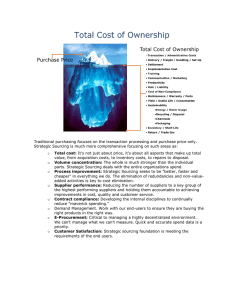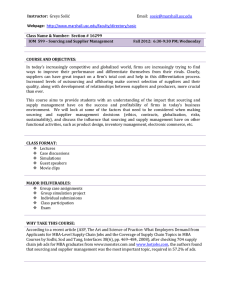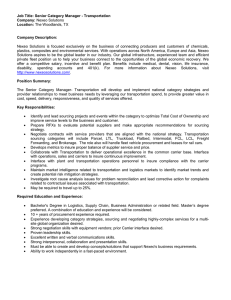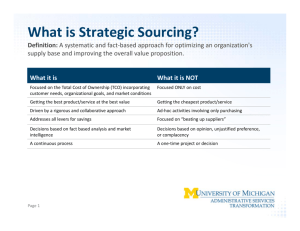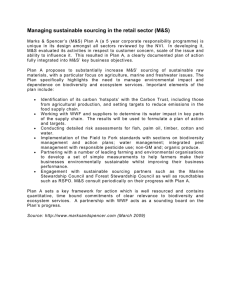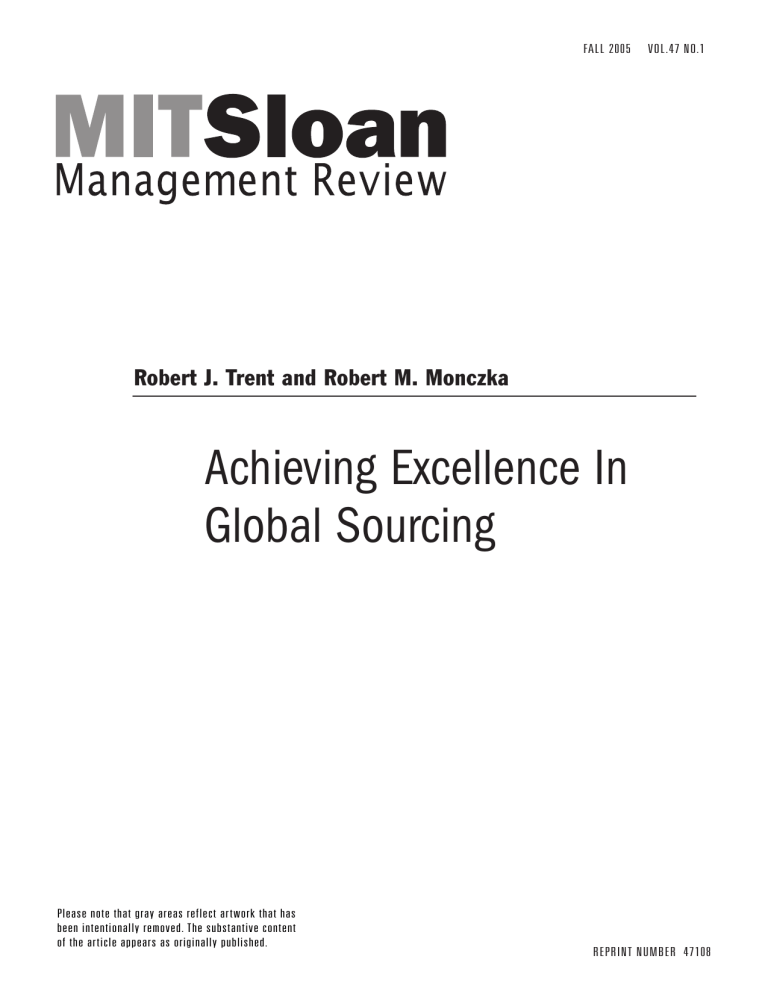
FALL 2005 VOL.47 NO.1 Robert J. Trent and Robert M. Monczka Achieving Excellence In Global Sourcing Please note that gray areas reflect artwork that has been intentionally removed. The substantive content of the article appears as originally published. REPRINT NUMBER 47108 Achieving Excellence In Global sourcing is an increasingly popular business strategy, but it’s not easy to execute. There are seven typical characteristics of organizations with outstanding global sourcing. Robert J. Trent and Robert M. Monczka s organizations search for new and better ways to compete, global business strategies will continue to receive increasing attention. One area in which globalization can move from concept to practice is global sourcing, an advanced approach to sourcing and supply management that involves integrating and coordinating common materials, processes, designs, technologies and suppliers across worldwide buying, design and operating locations. Since most organizations do not have well-developed global sourcing strategies in place, improvement opportunities in this area are attractive and as yet largely unrealized. Shifting from a narrow cost-reduction emphasis to an emphasis on globally integrated and coordinated sourcing strategies should improve an organization’s competitiveness.1 Our research suggests that many executive managers, particularly at large U.S.-based manufacturing companies, clearly desire to obtain the benefits available from more advanced sourcing approaches. The reality, however, is that most companies currently lack the understanding, capability or willingness to operate at such demanding levels. This can have serious consequences when companies have competitors that truly understand how to integrate and coordinate their worldwide activities. Companies that produce and sell worldwide should no longer view global sourcing as an emerging strategy. From our research, we have identified key features that characterize leading global sourcing organizations. These characteristics will help executives understand what an effective global organization looks like and compare their progress and practices against global sourcing best practices. The participants in our research were primarily large, North American–based multinationals, involved largely in manufacturing rather than services. (See “About the Research,” p. 26.) Given the size and location of participating companies, we make no claims about whether the results of the study can be generalized to a broader population of companies, particularly to small and medium-sized companies, or to companies headquartered outside the United States. A Global Sourcing Defined “International purchasing” and “global sourcing” are terms that have very specific meanings in our research. Although many researchers and practitioners interchange the terms, fundamental differences exist between them. International purchasing involves a commercial transaction between a buyer and a supplier located in different countries. Global sourcing, on the other hand, involves integrating and coordinating common items, materials, processes, technologies, designs and suppliers across worldwide buying, design and operating locations. The progression from domestic buying to international purchasing and then to global sourcing can be visualized as movement along a continuum through five different levels. Robert J. Trent is Supply Chain Management Program director and Eugene Mercy Associate Professor of Management at Lehigh University. Robert M. Monczka is Distinguished Professor and ISM Professor of Supply Chain Management at W.P. Carey School of Business, Arizona State University, and director of strategic sourcing and supply chain research at CAPS: Center for Strategic Supply Research. Contact them at rjt2@lehigh.edu and rmm@monczka.com. 24 MIT SLOAN MANAGEMENT REVIEW FALL 2005 Global Sourcing (See “Five Levels of Sourcing,” p. 28.2) In moving from domestic purchasing to international purchasing, organizations must contend with longer distances, increased rules and regulations, currency fluctuations, customs requirements, and language, cultural and time differences. Companies that then go on to pursue global sourcing must contend with the operational issues that affect international purchasing while also managing a higher level of cross-functional and cross-locational coordination. The reasons behind the progression from domestic to international purchasing have been well studied, along with the issues associated with the progression.3 Organizations that practice strictly domestic purchasing (Level I) often progress toward international purchasing (Level II) because they are confronted with a requirement for which no suitable domestic supplier exists or because competitors are gaining an advantage due to their sourcing practices. Level I companies may also find themselves driven toward international purchasing because of a supply disruption, rapidly changing currency exchange rates, a declining domestic supply base, inflation within the home market or the emergence of new supply sources. International purchasing at Level II is usually limited or performed on an ad hoc or reactive basis. Companies often start making international purchasing part of their sourcing strategy (Level III) once they recognize that purchasing internationally can lead to a range of performance improvements. However, strategies at this stage are not well coordinated across worldwide buying sites or locations and usually focus on price improvements. More companies in our sample currently operate at Level III than at any other level. The fourth level, the first of two global sourcing levels in our model, features integrated and coordinated sourcing strategies across worldwide buying or site locations. Operating at this level requires worldwide information systems, personnel with advanced knowledge and skill sets, extensive coordination and communication mechanisms, an organizational structure that supports global integration and an executive leadership that can clearly articulate a global vision. The strategy integration that occurs at Level IV is primarily among buying locations and mainly considers the development of global sourcing agreements. (A global sourcing agreement or contract is one that applies throughout an entire company, usually with a supplier that has global capabilities.) An organization at this level may have wide discrepancies in Illustration: © Campbell Laird/images.com FALL 2005 MIT SLOAN MANAGEMENT REVIEW 25 terms of the extent of coordination in various major purchase categories. It may be progressive in coordinating its sourcing of capital equipment purchases across its locations but fail to coordinate raw material requirements. Or it may excel at coordinating the sourcing of facility support services but not pursue opportunities within other service areas. The challenge is to move from having pockets of excellence to addressing global opportunities wherever they exist. Two primary distinctions separate companies operating at Level IV and Level V. In companies at Level V, the highest global sourcing level, integration and coordination occur not only among worldwide buying locations but also across functional groups, including operations, marketing and engineering. This integration, which often involves the coordination of design and procurement activities, occurs during the development of new products and technology as well as during the sourcing of items or services to fulfill existing demand. In addition, Level V companies focus on more than simply developing global agreements or contracts; they also work to standardize their supply management processes and practices worldwide. Most participants in our research, and probably most companies in general, expect to progress toward a more advanced sourcing level. However, most lack the ability, the willingness or even the need to operate at Levels IV and V. For some, a progression toward Level IV would be a major accomplishment. For others, particularly smaller and medium-sized companies with limited geographic reach and capabilities, Level III might be a more realistic option. Part of a company’s strategic planning process should include determining an appropriate sourcing level. Despite the complexities associated with global sourcing, the process offers advantages.4 During the quantitative portion of our research, respondents evaluated the degree to which they have realized 16 separate benefits from their sourcing efforts. Companies that engage in global sourcing realize every benefit to a greater extent than companies that merely engage in international purchasing. In fact, the average rating for all benefit areas was 32% higher for companies that have achieved some level of global sourcing than for those companies that pursue international purchasing. Certain benefits, such as greater sourcing consistency among locations or better management of total supply chain inventory, are only available once an organization takes an integrated approach to its global strategies and practices. Air Products and Chemicals, Inc., an Allentown, Pennsylvania, company that designs and operates industrial gas and chemical facilities in dozens of countries, has experienced the benefits of advanced global sourcing. After three years of experience with the process, Air Products has more than 100 global sourcing agreements in place, which are yielding average unit cost savings of About the Research The conclusions presented here are part of the Global Sourcing Research Project, an exploratory project that investigated the development of global sourcing processes and strategies. This project included an extensive review of previous research, information obtained through site visits to 15 leading companies and quantitative data collected from executives responsible for the international and global activities at 162 different companies. The quantitative research relied on survey data provided by respondents selected randomly from a database of supply executives. Researchers intentionally selected names from a database consisting of larger rather than smaller companies because experience suggested that larger companies are more likely to pursue the kinds of activities that were of interest. The average participating company had annual sales of 26 MIT SLOAN MANAGEMENT REVIEW FALL 2005 $1.5 billion. Thirty-eight percent of respondents worked for companies with annual sales of $500 million or less, 31% worked for companies with sales of $500 million to $3 billion, 15% worked for companies with sales of $3 billion to $10 billion, and 16% worked for companies with sales over $10 billion. Of 1,800 surveys forwarded worldwide, 162 were returned, yielding a 9% response rate. Some companies elected not to participate due to their inexperience with worldwide sourcing activities. Furthermore, the response rates for surveys sent outside the United States were low, resulting in a final sample that contained a large percentage of U.S. companies. The participants in this study were primarily large, North American–based multinationals involved largely in manufacturing. Most respondents (91%) in the final sample were vice presidents or managers working at the corporate level rather than at the division or site level. Represented industries included industrial products (39%), consumer products (15%), high technology (8%), services (9%), basic materials, utilities and energy (each at 3%), retailing (1%) and other diversified companies (19%). Industry experts who are familiar with leading-edge practices helped identify the 15 companies visited during the field research. Visited companies compete in the chemical, electronic, computer, process control, consumer products and transportation equipment industries. Field visits featured face-toface interviews with sourcing team members and leaders, executive steering committee members, executives and others closely involved with global sourcing. Site visits provided a level of detail that was not possible through the analysis of quantitative data. One company, with operations in more than 100 countries, has demonstrated its commitment to global sourcing by creating a formal position best described as a sourcing “czar.” 20%. Furthermore, the company’s worldwide engineering and procurement centers have better aligned their strategies with one another and with the company’s business strategy. An added bonus is that sourcing managers now work with marketing staff to include expected savings from global agreements when bidding on new business opportunities. Integrated global sourcing is helping a company that operates in a mature yet intensely competitive industry gain new market share.5 The Characteristics of Outstanding Global Sourcing On the basis of our research findings, we have identified a set of features characterizing organizations that are especially effective at global sourcing. (See “Characteristics of Global Sourcing Excellence,” p. 30.) The features cluster into seven broad characteristics: I Executive commitment to global sourcing I Rigorous and well-defined processes I Availability of needed resources I Integration through information technology I Supportive organizational design I Structured approaches to communication I Methodologies for measuring savings Few organizations, if any, demonstrate all the detailed features presented here. However, this profile can serve as a benchmark, allowing executives to compare their company’s current capabilities and features with best practices in global sourcing. #1: Executive Commitment to Global Sourcing It’s hard to imagine a process as complex as global sourcing becoming a reality without an executive champion who has the authority and ability to translate a vision into practice; global sourcing does not migrate up from the bottom of an organization. Best-practice companies recognize the importance of a high-level individual who can develop and communicate a global sourcing vision and is responsible for its overall success. This individual should also be respon- sible for making strategy presentations to the executive committee and to the board of directors. A leader who has access to the highest executive levels will help differentiate successful global efforts from less successful ones. At companies that are proficient at global sourcing, an executive steering committee or council is often formed to oversee the process. The steering committee at a leading electronics company, for example, includes the vice president of research, the vice president of supply chain management, the corporate controller, the vice president of marketing and sales and the vice president of information technology. Each committee member is responsible for championing a global project that relates to a major purchase category. The CEO, whom the steering committee reports to regularly, stated that the development of a global sourcing process was one of his primary initiatives during a recent planning period. This pronouncement quickly resulted in support for global sourcing from functional managers and a willingness to take on steering committee responsibilities. Another company, which has operations in more than 100 countries, has demonstrated its commitment to global sourcing by creating a formal position that is best described as a sourcing “czar.” This manager, a well-respected engineer with more than 25 years of experience, works closely with an executive steering committee to prioritize sourcing opportunities while overseeing the process. He recruits team members, allocates budget to specific projects, helps teams establish improvement targets, meets weekly with project teams and looks for ways to continuously improve the global sourcing process. He is currently leading an initiative to develop tools and databases to support better sourcing decision making and consistency at every level and location. Executive leaders can demonstrate commitment in many other ways, through both speech and action. They can fund the development of a well-defined global process; make staff and budget available to support global sourcing project teams; promote site and plant-level buy-in for global activities and agreements; and stress the importance of global sourcing to other groups within the company. #2: Rigorous and Well-Defined Processes Developing a welldefined and adhered-to process is a global sourcing best practice.6 In our research, respondents were asked to compare their most and least successful global sourcing experience by considerFALL 2005 MIT SLOAN MANAGEMENT REVIEW 27 information, time and help from others outside the sourcing process. Leading companies recognize the importance of these resources and make them available before global initiatives even commence. The executive steering committee at one company, for example, provides a travel and living budget at the time a work team is formed. This alleviates the concerns of the company’s functional managers, who had expressed strong reluctance to use their budgets to cover global sourcing expenses. Time is perhaps the most essential resource to commit to global initiatives, but also the least available, as an earlier study has concluded.9 That study also found that the statistical correlation between time availability and team effectiveness was higher than for any other resource category. Since most organizations rely on team members who have other responsibilities, an important role for steering team members involves negotiating with functional managers to ensure that participants can commit the necessary time. One theme that consistently emerges when working with leading global sourcing companies is the importance of qualified personnel. In the quantitative portion of our research, the factor identified as most important to global sourcing success was access to personnel with the right knowledge, skills and abilities. Respondents ranked a lack of qualified personnel as the most serious of a dozen potential problems that could affect global sourcing success. The knowledge and skills required for global sourcing differ dramatically from those required for site-based sourcing, and that represents a challenging barrier in the short term. Most #3: Availability of Needed Resources Various resources can procompanies have created decentralized supply organizations that mote or interfere with the translation of a global vision into are proficient at managing transactions and material flows and effective practices.8 The availability of needed resources has the tend to favor familiar supply sources. Global sourcing, however, potential to separate marginally performing from exceptionally requires individuals who can view supply markets from a performing global-sourcing organizations. The most critical worldwide perspective while collaborating across functional resources usually are access to qualified participants, budgets, boundaries, particularly between engineerFive Levels of Sourcing ing and procurement. As with any compaThe movement from domestic purchasing to integrated global sourcing can be viewed as a continuum nywide initiative that with five stages. The majority of survey respondents now practice some form of international purchasrelies on teams, help ing, but most anticipate moving to a global sourcing approach over the next five years. from outside the team is often critical. This International Purchasing Global Sourcing may include legal help Level I Level II Level III Level IV Level V when reviewing contracts, technical help Domestic International International Global Sourcing Global Sourcing when evaluating supPurchasing Purchasing Only Purchasing as Strategies Strategies Only as Needed Part of Integrated Across Integrated Across plier proposals or help Sourcing Worldwide Worldwide Strategy Locations Locations and when evaluating supply Functional Groups sources or collecting Percent of companies operating or expecting to operate at a particular level (N=169) data. A best practice is Currently 13.4% 21.3% 31.0% 18.1% 16.1% Future Plans 7.8% 7.8% 14.3% 15.6% 54.5% to identify those indiExpected Change –42.0% –63.0% –54.0% –14.0% +239.0% viduals who must suping 22 factors. The presence of a well-defined sourcing approach or process was found to be the strongest differentiator between successful and less successful global efforts. Developing a systematic global sourcing process makes sense for a number of reasons. It accelerates learning as participants become familiar and experienced with a defined process. It “builds in” best practices and knowledge that enhance the likelihood of success. Perhaps most importantly, it allows organizations to document, measure and continuously improve. A defined global sourcing process also helps overcome many of the differences that exist among locations — such as social culture and laws, personnel skills and business culture — thereby aligning participants and practices around the world with the broader corporate interests. The global sourcing processes we studied share certain features: a widely communicated and understood process that becomes the foundation for pursuing integrated global sourcing; the designation of a process owner who has responsibility for reviewing and improving the process; and “lessons learned” sessions conducted at the end of each project, with results forwarded to global team members and leaders. In addition, contracts are continuously monitored, reviewed and reestablished as required. By requiring global teams to provide regular updates and to meet stringent milestones, the process allows executive leaders to practice what Takeuchi and Nonaka term “subtle control.”7 28 MIT SLOAN MANAGEMENT REVIEW FALL 2005 The use of teams to analyze and propose sourcing strategies remains a popular and growing organizational design option, but leaders should keep in mind the barriers to their use. port a global initiative before forming a project team. When the team is formed, people external to the team are identified as “as needed” resources. Global sourcing demands an unusual amount and variety of information, often from diverse and dispersed operating locations. Needed data include information about existing contracts and suppliers; incumbent supplier performance and capabilities; projected demand by commodity and location; capabilities of potential suppliers, including suppliers in emerging markets such as China; and internal customer requirements. A lack of information about potential suppliers often results in a reliance on current suppliers, which may not be the best sourcing option. #4: Integration Through Information Technology While it seems obvious that accessible data and information support analysis on a global level, the reality is that companies often struggle in this area. Many companies have grown through mergers and acquisitions, and newly combined units rarely have compatible contracts, systems or material-coding schemes. During our research, respondents rated their ability to aggregate common requirements across buying units as an important success factor for global sourcing. Best-practice companies address these issues by creating global data warehouses and contract repositories that use companywide coding schemes for easier aggregation of requirements and by assigning a commodity or category code to every major item and service required in their businesses. This allows efficient access to information when analyzing global sourcing opportunities. Perhaps the most advanced information support system observed during our research exists at a producer of automated control systems. The company collects data on every supply chain transaction at each operating location. Analysts across the company can quickly identify worldwide usage requirements by commodity, compare supplier performance across locations, review any contracts currently in place and compare actual prices against contracted prices. This system also validates the savings that are realized from global sourcing agreements, and the savings are reported regularly to the chief financial officer and executive committee. In addition to data warehouses and repositories, leading companies rely extensively on Web-based systems and intranets to make global sourcing information widely available within the company. One company that is noted for its creative use of information technology has placed a wide range of support docu- ments on its intranet, including an online manual that describes the company’s global sourcing process; a global strategy development template; a contract terms and conditions checklist; a report that identifies the status of completed, in-process, authorized and future global sourcing opportunities; a request for proposal template; and currency risk-management guidelines. The company has also created a system that allows users at any location across the organization to search for approved suppliers. As an added feature, this system provides advance notification of any contracts that will expire during the next three to six months. #5: Supportive Organizational Design “Organizational design” is a broad term that refers to the process of assessing and selecting the structure and formal system of communication, division of labor, coordination, control, authority and responsibility required to achieve an organization’s goals.10 Executive leaders should not overlook the important relationship between organizational design and the success of major initiatives, including global sourcing initiatives. Businesses that excel at global sourcing often share three organizational design features. Two of those features — a formal executive steering committee to guide the global process and an executive leader who has accountability for global results — have been discussed above. A third is extensive reliance on teams to analyze and propose sourcing strategies. An earlier study involving 172 U.S. companies examined the organizational design features that companies rely on when pursuing their supply chain objectives.11 While only one-fifth of the design features that respondents were asked to evaluate involved teams, team-related features represented three of the seven features ranked as the most widely used. The study concluded that the use of teams remains a popular and growing organizational design option. Executive leaders should plan for and use teams selectively, always keeping in mind the barriers to their use. One barrier involves relying on part-time team members who have other job responsibilities. Dual responsibilities often lead to conflict as members manage time and reporting pressures. Another barrier involves teams whose members rarely, if ever, meet in person. Just as global sourcing makes communication among participants more complicated, it also makes supplier evaluation and selection decisions more complex. Given the performance FALL 2005 MIT SLOAN MANAGEMENT REVIEW 29 requirements demanded of global suppliers and the extremely high cost of switching suppliers after selection, it is not surprising that survey respondents rated site visits to evaluate supplier capabilities as an important success factor. One approach is to use teams to conduct visits; another relies on international purchas- ing offices to conduct direct evaluations of supplier capabilities. These offices, usually staffed by people from the country or region where the office is located, help identify potential suppliers, solicit price quotations, conduct site visits, obtain product samples and support negotiations. International purchasing Characteristics of Global Sourcing Excellence While few, if any, companies possess every feature detailed on this list, these characteristics were identified through qualitative and quantitative research about global sourcing best practices. 1. Executive Commitment to Global Sourcing I Cross-functional leaders participate on a global sourcing steering committee or council. I 5. Supportive Organizational Design I A designated executive has the authority to translate a global vision into reality. A formal executive steering committee or council oversees the global sourcing process, including the identification of global sourcing opportunities. I I Executive leaders work to gain support for global agreements and processes from cross-functional groups and buying locations. Cross-functional project teams are responsible for the detailed analysis of global opportunities and the development of sourcing agreements. I I Global sourcing leaders make strategy presentations to the executive committee and to the board of directors. Organizational design includes the separation of strategic activities, such as global sourcing, and operational activities, such as the routine reordering of material. I Executive leaders recruit qualified participants to join global sourcing project teams. I International purchasing offices support global sourcing requirements. I Sourcing support personnel are (1) located near technical and marketing personnel during new product development projects and (2) linked organizationally to the appropriate global sourcing team. 2. Rigorous and Well-Defined Processes I A well-defined process is in place that requires participants to establish goals, meet milestones and report progress to executives. I An executive leader or steering committee, with input from participants, reviews and proposes process improvements. I “Lessons learned” sessions are conducted at the conclusion of each project, and findings are distributed to worldwide participants. I Global agreements are continuously monitored, reviewed and reestablished as required. 6. Structured Approaches to Communication I Project teams meet regularly, either face-to-face or electronically, to coordinate efforts. I Strategy review and coordination sessions ensure understanding of global initiatives and buy-in for them. I Project teams regularly report progress to executive leaders. I Advanced communication and coordination tools are available, including videoconferencing and Web-based collaboration tools. I Project information and updates are posted on a company intranet. 3. Availability of Needed Resources I Executives make critical resources, such as budgets and qualified participants, available to support global initiatives. I The process involves individuals who have the ability to take a global sourcing perspective rather than a local or regional perspective. I I Relevant information is accessible to project teams and participants. Finance representatives agree on methods of validating savings from global initiatives. I Global sourcing participants meet regularly with executive leaders to review savings from existing agreements and expected savings from in-process activities. I Measurement systems support the calculation of — Companywide savings realized and expected to be realized from global agreements — The impact that sourcing initiatives have on corporate financial measures (e.g., return on assets) — The return on investment for individual projects — The impact that global suppliers have on buying location performance indicators 7. Methodologies for Measuring Savings 4. Integration Through Information Technology 30 I Data warehouses provide access to required data and information on a real-time basis. I A companywide intranet provides access to global sourcing support documents, guidelines, templates and progress updates. I Contract repositories store global agreements and provide warning of expiring agreements. MIT SLOAN MANAGEMENT REVIEW FALL 2005 offices also help with the many operational issues that arise after a supplier selection decision. Organizations that are committed to global sourcing should seriously consider making international purchasing offices part of their structure. #6: Structured Approaches to Communication Participants in global sourcing initiatives are often located around the world, making real-time and face-to-face interaction difficult. Furthermore, participants may speak various languages and adhere to different business practices, cultures and laws. When research participants identified the factors most critical to worldwide sourcing success, a well-established approach to communication and coordination was highly rated. Leading companies rely on various methods to manage their communication requirements, such as regular strategy review meetings, training sessions involving team members from each site or region and regular project updates reported through an intranet. A common approach for coordinating team efforts is to rely on scheduled conference calls, usually on a weekly basis. Other widely used options include videoconferencing and Webbased meeting tools. Leading companies also commit the time and budget to conduct strategy review and coordination sessions, another highly rated success factor according to survey respondents. These meetings, often featuring face-to-face interaction, provide an opportunity for managers to better understand an organization’s global strategies. Review sessions also reduce redundancy and misunderstanding among global participants and worldwide locations. #7: Methodologies for Measuring Savings A frustration often voiced during field interviews was an inability to articulate or validate the savings derived from global sourcing agreements. A vice president at a top consumer products company said that one of his group’s greatest failures has been an inability to validate the savings from global sourcing and confirm its value. This failure is in part due to a lack of interest from the finance department in evaluating the savings realized from global agreements. This company’s inability to document savings has resulted in some of its managers viewing global sourcing as an expense rather than an investment. Unfortunately, quantifying and validating the direct benefits of globalization, particularly in areas such as better inventory management or increased process consistency, is not an easy task. Best-practice companies have the capability to validate unit cost savings from global activities and report them, usually to executive and site-based managers. Validation usually involves a finance group verifying that actual prices are lower than a prior base price or comparing actual price changes to market price changes. The producer of automated control systems mentioned earlier had the most advanced validation system observed during our research. To identify unit cost savings across the organiza- tion, the company’s system compares current prices paid against the last price paid during the previous year, which is considered the base price for the current year. The finance department has agreed that the system is reporting actual savings that should be forwarded directly to executive management. While the ability to measure unit cost savings from worldwide sourcing is certainly desirable, total cost savings from global sourcing are never equal to unit cost savings. In fact, respondents in our survey estimated that one-quarter of unit cost savings achieved through global sourcing are consumed by the added complexities and costs associated with international transactions. Unfortunately, few companies currently have systems that accurately capture the total costs associated with worldwide buying. We expect that organizations that are serious about global sourcing will develop measurement systems that look beyond unit cost. Currently, more progressive companies calculate the impact that global sourcing savings have on measures that capture the attention of executive leaders, such as return on assets. These companies also show how savings from global sourcing agreements affect the financial performance indicators at individual sites. This helps create buy-in to the process from site locations, which is a critical success factor. Additionally, some companies incorporate current and expected global savings when calculating their financial projections. Best-practice companies use measurement to promote companywide process consistency. Instead of reinventing a methodology for evaluating potential suppliers, buying locations can use assessment criteria and measures that are consistent across a company, with adaptation as required. The performance of incumbent suppliers also can be evaluated with a companywide scorecard that includes a defined measurement process and metrics. Looking Ahead Executive leaders should view global sourcing as a continuously evolving strategy area and process that, if managed and supported properly, should provide a steady stream of benefits. Interviews with sourcing executives reveal that they plan to enhance and expand their global sourcing practices across a number of important areas. In particular, many sourcing leaders recognize the need to accelerate the development of a global rather than local or regional view of the supply network. Other needed enhancements include developing a set of global performance measures, establishing compatible information systems across the value chain and pursuing worldwide consistency in different sourcing processes, such as supplier evaluation and development. Leading companies also expect their global efforts to promote even greater integration between marketing, engineering and sourcing groups. Looking across many industries reveals something they each have in common: The pressure to improve is severe and relentless. 32 MIT SLOAN MANAGEMENT REVIEW FALL 2005 The companies that succeed will be the ones that have learned how to leverage and coordinate their activities on a worldwide basis. For many, integrated global sourcing may offer the best opportunity to achieve the kinds of performance breakthroughs required in highly competitive industries. Realizing these breakthroughs, however, demands a thorough understanding of what an effective global organization looks like. And it requires executive leaders who can define, support and put into place the practices that translate a global vision into a global reality. REFERENCES 1. A.C. Samli, J.M. Browning and C. Busbia, “The Status of Global Sourcing as a Critical Tool of Strategic Planning,” Journal of Business Research 43, no. 3 (1998): 177-187. 2. The continuum presented in this diagram has its roots in research performed in the early 1990s. See R.M. Monczka and R.J. Trent, “Global Sourcing: A Development Approach,” International Journal of Purchasing and Materials Management 27 (spring 1991): 2-8. 3. For a discussion of specific topics related to international purchasing, see M.S. Alguire, C.R. Frear and L.E. Metcalf, “An Examination of the Determinants of Global Sourcing Strategy,” Journal of Business and Industrial Marketing 9, no. 2 (1994): 62-74; U. Arnold, “Global Sourcing: An Indispensable Element in Worldwide Competition,” Management International Review 29, no. 4 (1989): 14-28; L.M. Birou and S.E. Fawcett, “International Purchasing: Benefits, Requirements, and Challenges,” International Journal of Purchasing and Materials Management 29 (spring 1993): 27-38; P.R. Murphy and J.M. Daley, “Logistics Issues in International Sourcing: An Exploratory Study,” International Journal of Purchasing and Materials Management 30 (summer 1994): 22-27. 4. For a detailed discussion of the differences between companies that pursue international purchasing and those that pursue global sourcing, see R.J. Trent and R.M. Monczka, “International Purchasing and Global Sourcing — What Are the Differences?” Journal of Supply Chain Management 39, no. 4 (2003): 26-38. 5. Authors’ interviews with managers at the company. 6. For a more detailed description of a leading company’s global sourcing process, see R.J. Trent and R.M. Monczka, “Pursuing Competitive Advantage Through Integrated Global Sourcing,” Academy of Management Executive 16, no. 2 (2002): 66-80. 7. H. Takeuchi and I. Nonaka, “The New New Product Development Game,” Harvard Business Review 64 (January-February 1986): 137-146. 8. L.H. Peters and E.J. O’Connor, “Situational Constraints and Work Outcomes: The Influences of a Frequently Overlooked Construct,” Academy of Management Review 5 (1980): 391-397. 9. R.M. Monczka and R.J. Trent, “Cross-Functional Sourcing Team Effectiveness,” (Tempe, Arizona: Center for Advanced Purchasing Studies, 1993). 10. D. Hellriegel, J.W. Slocum and R.W. Woodman, “Organizational Behavior” (Cincinnati, Ohio: South-Western College Publishing, 2001), 474. 11. R.J. Trent, “The Use of Organizational Design Features in Purchasing and Supply Management,” Journal of Supply Chain Management 40, no. 3 (2004): 4-18. Reprint 47108. For ordering information, see page 1. Copyright © Massachusetts Institute of Technology, 2005. All rights reserved. PDFs ■ Reprints ■ Permission to Copy ■ Back Issues Electronic copies of MIT Sloan Management Review articles as well as traditional reprints and back issues can be purchased on our Web site: www.sloanreview.mit.edu or you may order through our Business Service Center (9 a.m.-5 p.m. ET) at the phone numbers listed below. To reproduce or transmit one or more MIT Sloan Management Review articles by electronic or mechanical means (including photocopying or archiving in any information storage or retrieval system) requires written permission. To request permission, use our Web site (www.sloanreview.mit.edu), call or e-mail: Toll-free in U.S. and Canada: 877-727-7170 International: 617-253-7170 e-mail: smrpermissions@mit.edu To request a free copy of our article catalog, please contact: MIT Sloan Management Review 77 Massachusetts Ave., E60-100 Cambridge, MA 02139-4307 Toll-free in U.S. and Canada: 877-727-7170 International: 617-253-7170 Fax: 617-258-9739 e-mail: smr-orders@mit.edu Reproduced with permission of the copyright owner. Further reproduction prohibited without permission.
